How To Respond To A Warning Letter At Work
[Your Name]
[Your Address]
[City, State, Zip Code]
[Email Address]
[Phone Number]
[Date]
[Recipient's Name]
[Recipient's Job Title]
[Company Name]
[Company Address]
[City, State, Zip Code]
Subject: Response to Warning Letter
Dear [Recipient's Name],
I hope this letter finds you well. I am writing in response to the warning letter I received on [date], and I want to express my appreciation for bringing the concerns to my attention. I have carefully considered the contents of the letter, and I take the matters raised very seriously.
I acknowledge that my recent actions/performance have not met the standards expected by [Company Name], and for this, I take full responsibility. I understand the impact my behavior may have had on the team and the organization, and I am committed to rectifying the situation promptly.
I sincerely apologize for any inconvenience or disruption caused by my actions. It was never my intention to create any issues, and I assure you that I will take immediate steps to address and improve the areas of concern.
To demonstrate my commitment to improvement, I have devised an action plan to ensure that such issues do not recur in the future:
1. [Outline specific action 1]
- [Explain how this action will address the concern]
- [Set a realistic timeline for implementation]
2. [Outline specific action 2]
- [Explain how this action will address the concern]
- [Set a realistic timeline for implementation]
3. [Outline specific action 3]
- [Explain how this action will address the concern]
- [Set a realistic timeline for implementation]
I understand the importance of adhering to [Company Name]'s policies and values, and I am fully committed to upholding them moving forward. I will actively seek feedback and guidance from my supervisors and colleagues to ensure continuous improvement in my performance and behavior.
Please know that I value my position at [Company Name] and the opportunities it provides. I am dedicated to regaining your trust and contributing positively to the success of the team and the organization.
Thank you for considering my response. I am open to further discussion regarding this matter and will gladly participate in any necessary meetings to address these concerns in person.
Once again, I apologize for any disappointment I may have caused, and I look forward to demonstrating significant improvement in the near future.
Sincerely,
[Your Name]
Professional Response to First Warning Letter
Dear [Manager's Name],
I acknowledge receipt of your warning letter dated [Date].
I sincerely apologize for the issue mentioned and take full responsibility for my actions.
I am committed to improving my performance and ensuring that this situation does not occur again.
Thank you for your guidance and understanding.
Formal Response to Warning Letter for Tardiness
Dear [Manager's Name],
I have received your warning regarding my repeated tardiness.
I understand the impact this has on the team and sincerely apologize for any inconvenience caused.
I have implemented measures to improve my punctuality and will ensure adherence to the company’s policies.
Thank you for bringing this matter to my attention.
Heartfelt Apology Response to Conduct Warning
Dear [Manager's Name],
I am writing in response to the warning letter issued on [Date] concerning my recent conduct.
I regret my behavior and fully acknowledge the mistake.
Please be assured that I am taking active steps to rectify my actions and uphold professional standards in the future.
Thank you for your patience and guidance.
Simple and Direct Response to Warning Letter
Dear [Manager's Name],
I acknowledge receipt of your warning letter dated [Date].
I accept the feedback provided and will take immediate action to correct the behavior.
Thank you for your attention.
Preliminary Response to Warning Letter for Miscommunication
Dear [Manager's Name],
I have received your warning regarding the recent miscommunication incident.
I apologize for the misunderstanding and will ensure that all future communications are clear and timely.
I appreciate your feedback and support as I work to improve.
Creative Response Highlighting Improvement Plan
Dear [Manager's Name],
I acknowledge your warning letter dated [Date] and take the concerns raised seriously.
To address the issue, I have drafted a personal improvement plan including [specific steps].
I am committed to following this plan to prevent recurrence and enhance my contributions to the team.
Thank you for your guidance and understanding.
Informal Response to Warning Letter for Remote Work Error
Hi [Manager's Name],
Thanks for bringing the issue to my attention regarding [specific error].
I realize my mistake and I’m already taking steps to ensure it doesn’t happen again.
Appreciate your understanding as I adjust my workflow.
Serious Response to Final Warning Letter
Dear [Manager's Name],
I acknowledge receipt of the final warning letter issued on [Date].
I fully understand the seriousness of this matter and take full responsibility for my actions.
I am committed to immediate improvement and to adhering strictly to all company policies moving forward.
Thank you for giving me the opportunity to correct my behavior.
Formal Email Response to Warning Letter Requesting Clarification
Dear [Manager's Name],
I acknowledge receipt of your warning letter dated [Date].
I would like to request clarification on certain points mentioned in the letter to ensure I fully understand the concerns and take appropriate corrective measures.
Thank you for your attention and support in helping me improve.
What / Why You Need a Response to a Warning Letter
A response to a warning letter is a formal acknowledgment and reply to a disciplinary notice from an employer.
- Demonstrates professionalism and accountability.
- Provides an opportunity to explain or clarify circumstances.
- Shows willingness to improve and maintain positive employment relations.
Who Should Send a Response to a Warning Letter
- Employees who have received a warning letter regarding conduct, performance, or other workplace issues.
- Individuals seeking to maintain a professional relationship with management.
- Staff wishing to formally document their acknowledgment and action plan.
Whom Should the Response Be Addressed To
- Direct supervisor or manager who issued the warning.
- Human resources department if involved in disciplinary matters.
- Senior management in cases of formal or final warnings.
When to Send a Response to a Warning Letter
- Immediately after receiving the warning letter.
- Before any deadlines or meetings related to disciplinary action.
- When clarification, apology, or a corrective plan is necessary.
How to Write and Send a Response to a Warning Letter
- Begin with acknowledgment of the letter and its receipt date.
- Express understanding and acceptance of the concerns raised.
- Offer an apology if applicable, taking responsibility for actions.
- Outline specific steps or measures to correct behavior.
- Close politely, showing commitment to improvement.
- Choose the medium: printed letter for formal warnings, email for digital correspondence.
How Many Responses Should Be Sent
- Typically, one formal response is sufficient.
- Additional follow-up may be sent if clarifications or updates on improvement plans are necessary.
- Avoid multiple responses unless requested by HR or management.
FAQ About Responding to Warning Letters
- Is it mandatory to respond?
While not always mandatory, it is highly recommended to demonstrate accountability. - Should I admit fault if I believe I am partially at fault?
Acknowledge the areas of responsibility while professionally explaining circumstances. - Can tone be informal?
Only in minor warnings or with close management; generally, formal tone is preferred. - Should I include a plan for improvement?
Yes, outlining corrective steps strengthens your response and shows commitment.
Requirements and Prerequisites Before Writing
- Thoroughly read and understand the warning letter.
- Gather facts, evidence, or context relevant to the issue.
- Understand company policies and disciplinary procedures.
- Plan a clear, professional, and sincere response.
Formatting Guidelines for a Response to a Warning Letter
- Length: 1–2 paragraphs for minor issues, up to a page for serious warnings.
- Tone: Professional, respectful, and sincere. Avoid aggressive or defensive language.
- Style: Formal for serious or final warnings; professional yet polite for minor ones.
- Mode: Email for quick response, printed letter for formal documentation.
- Etiquette: Address the correct recipient, acknowledge the concern, and provide constructive response.
After Sending a Response to a Warning Letter
- Keep a copy for personal and HR records.
- Monitor for acknowledgment or follow-up requests.
- Implement the corrective actions promised.
- Maintain professional behavior to demonstrate improvement.
Tricks and Tips for Effective Responses
- Be concise but thorough in addressing the concerns.
- Use a respectful and neutral tone.
- Include concrete steps for improvement to show commitment.
- Avoid blaming others or making excuses.
- Review for grammar, clarity, and professionalism before sending.
Common Mistakes to Avoid
- Ignoring the warning or failing to respond.
- Responding with defensive or emotional language.
- Over-explaining or including irrelevant details.
- Failing to outline corrective measures.
- Missing deadlines or sending to the wrong recipient.
Elements and Structure of a Response to a Warning Letter
- Acknowledgment: Confirm receipt of the warning letter.
- Understanding: Show comprehension of the issue or concern.
- Apology/Acceptance: Admit responsibility where appropriate.
- Corrective Plan: Outline steps to prevent recurrence.
- Closing: Express commitment to improvement and appreciation for guidance.
- Signature: Name, position, and date.




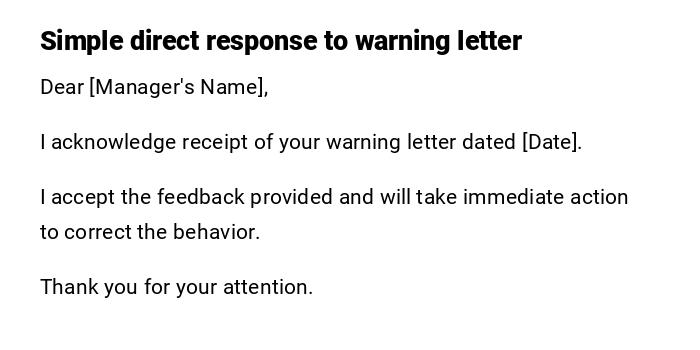
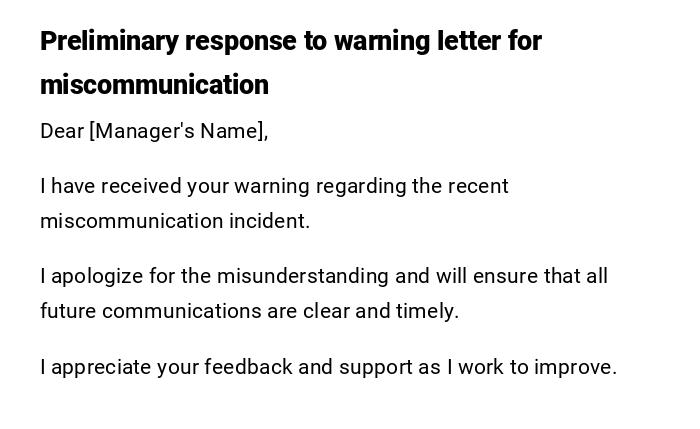
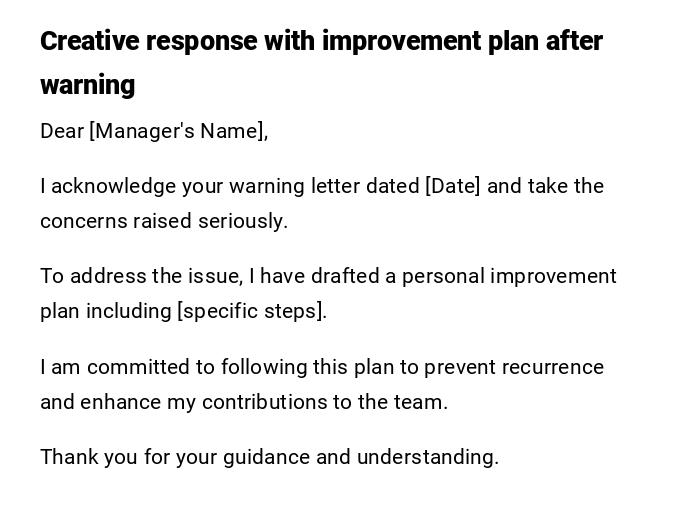
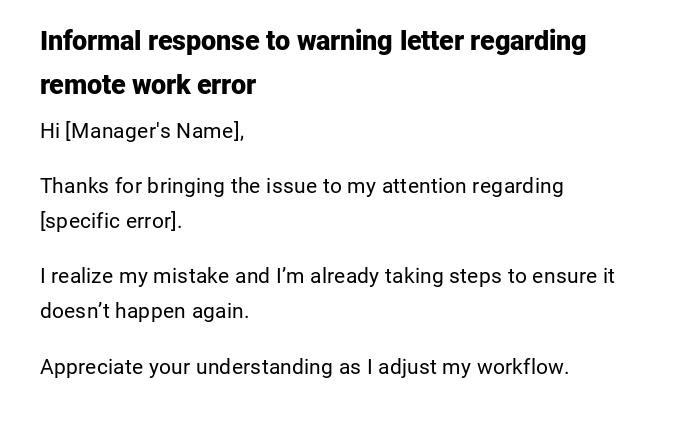
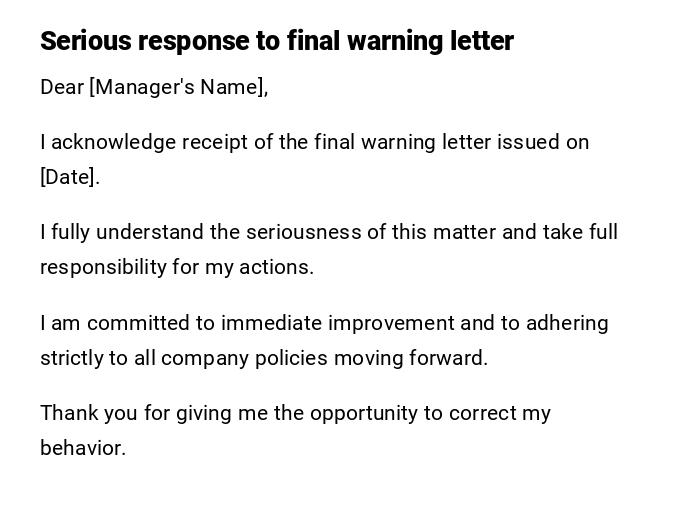
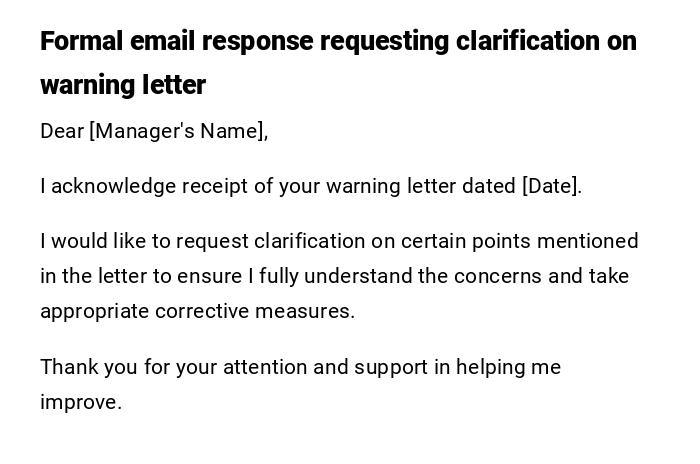

 Download Word Doc
Download Word Doc
 Download PDF
Download PDF